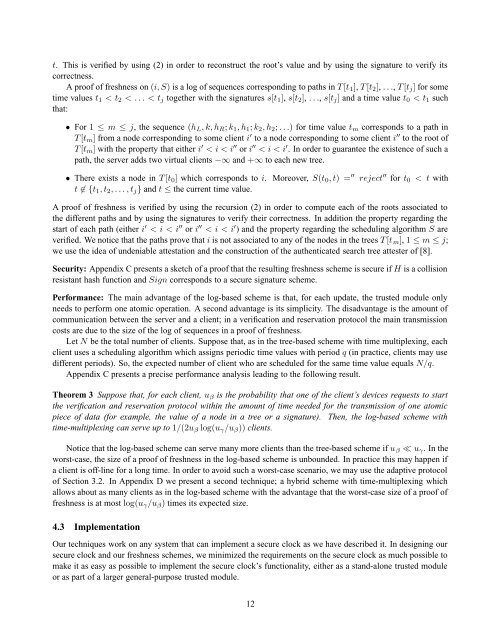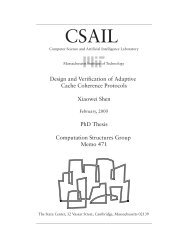Proof of Freshness - Computation Structures Group - MIT
Proof of Freshness - Computation Structures Group - MIT
Proof of Freshness - Computation Structures Group - MIT
Create successful ePaper yourself
Turn your PDF publications into a flip-book with our unique Google optimized e-Paper software.
t. This is verified by using (2) in order to reconstruct the root’s value and by using the signature to verify its<br />
correctness.<br />
A pro<strong>of</strong> <strong>of</strong> freshness on (i, S) is a log <strong>of</strong> sequences corresponding to paths in T [t1], T [t2], . . ., T [tj] for some<br />
time values t1 < t2 < . . . < tj together with the signatures s[t1], s[t2], . . ., s[tj] and a time value t0 < t1 such<br />
that:<br />
• For 1 ≤ m ≤ j, the sequence (hL, k, hR; k1, h1; k2, h2; . . .) for time value tm corresponds to a path in<br />
T [tm] from a node corresponding to some client i ′ to a node corresponding to some client i ′′ to the root <strong>of</strong><br />
T [tm] with the property that either i ′ < i < i ′′ or i ′′ < i < i ′ . In order to guarantee the existence <strong>of</strong> such a<br />
path, the server adds two virtual clients −∞ and +∞ to each new tree.<br />
• There exists a node in T [t0] which corresponds to i. Moreover, S(t0, t) = ′′ reject ′′ for t0 < t with<br />
t ∈ {t1, t2, . . . , tj} and t ≤ the current time value.<br />
A pro<strong>of</strong> <strong>of</strong> freshness is verified by using the recursion (2) in order to compute each <strong>of</strong> the roots associated to<br />
the different paths and by using the signatures to verify their correctness. In addition the property regarding the<br />
start <strong>of</strong> each path (either i ′ < i < i ′′ or i ′′ < i < i ′ ) and the property regarding the scheduling algorithm S are<br />
verified. We notice that the paths prove that i is not associated to any <strong>of</strong> the nodes in the trees T [tm], 1 ≤ m ≤ j;<br />
we use the idea <strong>of</strong> undeniable attestation and the construction <strong>of</strong> the authenticated search tree attester <strong>of</strong> [8].<br />
Security: Appendix C presents a sketch <strong>of</strong> a pro<strong>of</strong> that the resulting freshness scheme is secure if H is a collision<br />
resistant hash function and Sign corresponds to a secure signature scheme.<br />
Performance: The main advantage <strong>of</strong> the log-based scheme is that, for each update, the trusted module only<br />
needs to perform one atomic operation. A second advantage is its simplicity. The disadvantage is the amount <strong>of</strong><br />
communication between the server and a client; in a verification and reservation protocol the main transmission<br />
costs are due to the size <strong>of</strong> the log <strong>of</strong> sequences in a pro<strong>of</strong> <strong>of</strong> freshness.<br />
Let N be the total number <strong>of</strong> clients. Suppose that, as in the tree-based scheme with time multiplexing, each<br />
client uses a scheduling algorithm which assigns periodic time values with period q (in practice, clients may use<br />
different periods). So, the expected number <strong>of</strong> client who are scheduled for the same time value equals N/q.<br />
Appendix C presents a precise performance analysis leading to the following result.<br />
Theorem 3 Suppose that, for each client, uβ is the probability that one <strong>of</strong> the client’s devices requests to start<br />
the verification and reservation protocol within the amount <strong>of</strong> time needed for the transmission <strong>of</strong> one atomic<br />
piece <strong>of</strong> data (for example, the value <strong>of</strong> a node in a tree or a signature). Then, the log-based scheme with<br />
time-multiplexing can serve up to 1/(2uβ log(uγ/uβ)) clients.<br />
Notice that the log-based scheme can serve many more clients than the tree-based scheme if uβ ≪ uγ. In the<br />
worst-case, the size <strong>of</strong> a pro<strong>of</strong> <strong>of</strong> freshness in the log-based scheme is unbounded. In practice this may happen if<br />
a client is <strong>of</strong>f-line for a long time. In order to avoid such a worst-case scenario, we may use the adaptive protocol<br />
<strong>of</strong> Section 3.2. In Appendix D we present a second technique; a hybrid scheme with time-multiplexing which<br />
allows about as many clients as in the log-based scheme with the advantage that the worst-case size <strong>of</strong> a pro<strong>of</strong> <strong>of</strong><br />
freshness is at most log(uγ/uβ) times its expected size.<br />
4.3 Implementation<br />
Our techniques work on any system that can implement a secure clock as we have described it. In designing our<br />
secure clock and our freshness schemes, we minimized the requirements on the secure clock as much possible to<br />
make it as easy as possible to implement the secure clock’s functionality, either as a stand-alone trusted module<br />
or as part <strong>of</strong> a larger general-purpose trusted module.<br />
12
















